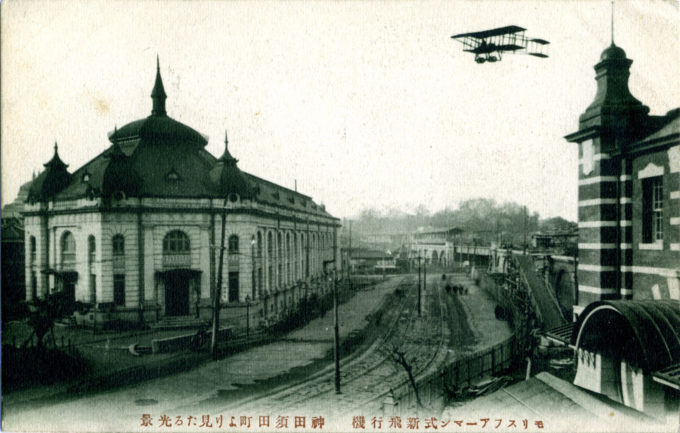
Kanda Post Office (left) at Manseibashi, c. 1915, with a Maurice Farman (MF.7 “Longhorn”) biplane passing overhead. A corner of the Manseibashi Station terminal can been at extreme right; Ochanomizu Station is seen in the distance.
See also:
Manseibashi Station, 1912-1936
“As early as 1908 Henry Farman had a school of aviation and construction works at Buc near Versailles. Somewhat later his brother Maurice Farman began to manufacture aircraft and in 1912 the brothers merged their interests in the Farman works at Boulogne-sur-Seine, making many planes of their characteristic pusher biplane type for military and training purposes.
“The first two Maurice Farman seaplanes were imported into Japan by the Navy and assembled at Oppama for initial flying demonstrations in October and November 1912. An additional two were purchased and used for flying training over a considerable period. The relatively simple construction was soon copied by the Yokosuka Naval Arsenal which added a small number to the four already imported. Being of the same type as that of the Army, they received the same short designation ‘Type 10’ Small Seaplane. These had fabric-covered wooden structures and were equipped with twin Tellier-type wooden floats. The two seats were in tandem in a fuselage pod, with a 70-hp Renault pusher-engine in the rear.
“When the Tsingtao Campaign erupted in September 1914, three of the imported ‘Type 10’ Small Seaplanes, together with one imported ‘Type 10’ Large Seaplane, were carried by the seaplane tender Wakarniya to participate in the campaign. They were soon joined by a fourth aircraft which was a Japanese-made ‘Type 10’ seaplane of the same type. These aeroplanes, manned by seven pilots during the two-month operation, succeeded in making 49 sorties during which they dropped 199 bombs.
“Working with Army aircraft in these air operations, they were unsuccessful in attacks on their most important target, the cruiser Kaiserin Elisabeth, but did succeed in sinking one small torpedo-boat with bombing attacks. However, one ‘Type Mo’ was downed by the German force’s sole working aircraft. The German pilot claimed downing the MF.7 with his pistol, the first aerial victory in aviation history.”
– Wikipedia

